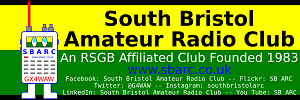Operating in a Net
There may be a few people, particularly newcomers to the hobby or those considering taking part in the hobby, who are unfamiliar with the concept and operation of a net. For these people the following general pointers are gladly provided.
Those familiar with the terms and conditions contained within our Licence will recognise that a net is one of the few occasions when we are legally permitted to "broadcast". Note that in the legal sense broadcasting has a different connotation than transmitting. Our licence permits us to operate transmitting equipment and to transmit signals but these signals are intended to be one to one, that is we transmit to one other intended recipient and hold a conversation (QSO) with that one other person. Whether others listen to this QSO is immaterial from the legal standpoint, it is the intent that our signal is intended for one other person that is important. Broadcasting, in the legal sense, means making a one to many transmission, that is the signals we broadcast are intended to be received by many individuals. Nets require us to transmit a signal intended to be received by all other participants in the net, it is a one to many transmission hence it is a broadcast. The other common situation where we broadcast is calling CQ as at the time of calling we have no idea how many people or who will reply to us thus we intend our signal to be received by many people in the hope that one of them will come back and engage in a QSO.
It is possible for a two way QSO to morph into an impromptu net if someone else comes across the QSO on air and asks to join in, this is not a problem. However this page is more focused on the formal types of net that usually occur with some degree of regularity on the same frequency at the same time of the day or week.
There are a number of regular nets that are supported by national or international groups, such as the Worked All Britain (WAB) net which comes together at various times dependent upon propagation and often involve mobile stations travelling through W.A.B. Squares.
| WAB Net Frequencies | ||
|---|---|---|
| BAND (m) | SSB (MHz.) | CW (MHz.) |
| 160 | 1.933 – 1.950 | 1.850 |
| 80 | 3.760 | 3.570 |
| 40 | 7.160 | 7.035 |
| 20 | 14.265 | 14.035 |
| 15 | 21.320 | 21.035 |
| 10 | 28.655 | 28.035 |
| 6 | 50.150 | – |
| 2 | 144.345 | – |
| Weekly 2m nets run on Friday evenings at 20:30 hours (UK local time) and Sunday mornings at 10:30 hours (UK local time) | ||
Additionally there are many local nets run by clubs or even individuals that can be a good place to contact local hams and introduce yourself.
Regular nets, as opposed to the impromptu type referred to previously, normally operate in one of two ways and it is advisable to spend a few minutes listening to the operation before you check in for the first time to ensure you understand how the group operates.
In all cases there will be a "NET CONTROLLER" whose function it is to ensure that everyone is in the net and gets their turn. How this is managed varies from net to net but generally either:
- The net controller notes the callsigns of those who call in and advises them of their position in the group and when their turn will be. This is usually based on some simple process such as the order in which stations checked into the net or alphanumeric callsign order. Once you know the order you wait for the person in front of you in the queue to speak and then when they finish the net automatically moves to you, you take your turn and pass it to the next person in the queue. Once everyone has had a turn and there are no other newcomers the first person takes their second turn and the process repeats. This is slightly less formal and tends to allow for a speedier net but relies on the participants to manage themselves and follow the rules of who to follow and who to pass onto.
- The net controller controls the net formally recording all those taking part and nominating who is to speak at any given point. In this operation a member of the net is invited to take his or her turn by the net controller, at the end of which the person speaking hands back to the net controller who then identifies the next station, who speaks and passes back to the net controller, and so on. Such a net is more flexible in that the if the net controller knows someone can add to information he or she can be invited to participate when the topic is in focus rather than waiting several overs for their turn to speak by which time the topic of conversation may have changed but it is a slower process overall and more onerous for the net controller.
